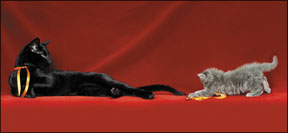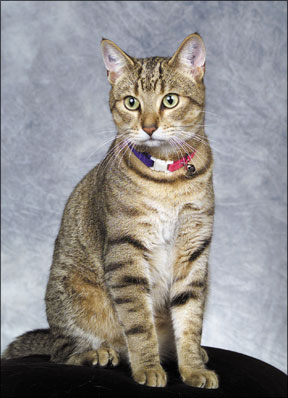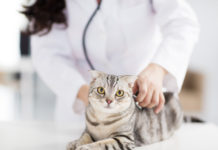Dear Elizabeth, I cant help feeling envious of the absolutely beautiful photos that have been taken of you. You are clearly a stunning cat of exquisite beauty, but I wonder how the photographers at the Feline Health Center have been able to capture your soul in their photos. I would dearly love to have some similar photos of my equally beautiful cats, but all I get are fuzzy, out-of-focus shots of their tails as they flee the room, or photos where their eyes are red and they look devilish. Do you have any tips that you could share?
Thanks for the flattering words, but the true credit must go to our talented Cornell photographer, Alexis Wenski-Roberts, who always presents me in the most complimentary light. (She also took the beautiful photographs that accompany the column this month.) I have picked up some tips from our photo shoots, and along with a bit of good luck, practice and perseverance, Im hopeful that these

288
tips will soon have you holding photos youll be proud of!
(1) Be relaxed and have fun! Cats, sensitive creatures that we are, pick up on moods, and if youre anxious, chances are good that your cats will be too. Theyll either run and hide or their expressions will reflect their anxieties, and you wont capture their true spirits.
(2) Use great light. The most important tip to getting great photographs is to use the best available light, which in most cases is natural light outside. Even if your cats are indoor-only cats, try taking them outside for photos. Of course your cats safety is paramount, so have someone hold them or use harnesses and leashes and dont attempt this if your cats are particularly nervous. Late-day sunlight is particularly flattering, and nice photos can also be obtained on bright but overcast days. If you cant bring the cats outdoors, take advantage of natural light coming in through windows or open doors, and turn on room lights. This will allow you to turn off the flash and avoid the dreaded red-eye and washed-out colors that result when a flash is used. Red-eye is mainly a problem when cats are looking directly at the camera and the light from the flash is reflected back at the camera from the cats retinas. If you must use a flash, take photos with your cats looking to the side instead of directly at the camera. Not only will you avoid red-eye, but the cats wont be temporarily blinded by the flash, a situation which leads some cats to run whenever they see the camera.
(3) Get down to their level. The best photos are taken from your

288
cats perspective. Lie on the grass or the floor or place the cats on the bed and kneel beside them. Focus on the eyes and shoot.
(4) Get close. Fill the frame with your cat and leave out distracting backgrounds. Use a zoom lens if your pets dislike having a camera in their faces.
(5) Keep photo sessions brief. Cats can be notoriously uncooperative when it comes to posing for photos, and most cats wont pose for very long, so get set up first, take a few practice shots and then bring the cats in.
(6) Work with your pets personalities. If they wont sit still for posed portraits, try photographing them while theyre napping, eating or playing with a favorite toy.
(7) Get help. An assistant standing behind you can offer treats, dangle toys or make unusual noises to catch the cats attention and get them to look at the camera.
(8) Hold the camera steady. Slight movement of the camera will result in blurry photos. Use a tripod, rest the camera on something solid, or rest your elbows on the ground if you need to.
(9) Shoot fast and shoot often. Experiment with lighting and positioning. Photographers take loads of photos in the hopes of getting just one ideal photograph, and you should do the same. With digital cameras, film costs are no longer an issue, so take lots and lots of photos.
(10) Keep your camera handy and ready to use so that youre ready when perfect opportunities arise. Best of luck!
Love, Elizabeth



